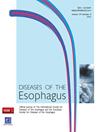349. TOTALLY MECHANICAL STAPLED SIDE-TO-SIDE VERSUS CIRCULAR END-TO-SIDE ANASTOMOSIS FOR MINIMALLY INVASIVE IVOR LEWIS ESOPHAGECTOMY: A MULTICENTER ANALYSIS
IF 2.3
3区 医学
Q3 GASTROENTEROLOGY & HEPATOLOGY
引用次数: 0
Abstract
Totally minimally invasive esophagectomy (TMIE) is increasingly used in treatment of patients with esophageal cancer. However, it is currently unknown if fully mechanical stapled side-to-side anastomosis for Ivor Lewis TMIE could be preferred for patients in whom both procedures are oncologically feasible. The study was performed in 2 high-volume China esophageal cancer centers between Feb 2015 through Dec 2022. Prospectively collected data from consecutive patients with esophageal cancer localized in the distal esophagus or gastroesophageal junction undergoing Ivor Lewis TMIE were included. The primary outcome parameter was anastomotic leakage requiring reintervention or reoperation. Secondary outcome parameters were operation characteristics, pathology results, complications, reoperations, length of stay, mortality, and overall survival (OS). 147 patients were included in this study. The incidence of anastomotic leakage requiring reintervention or reoperation was 12.9% after fully mechanical stapled side-to-side versus 11.8% after circular end-to-side anastomosis (P = 0.852). Fully mechanical stapled side-to-side Ivor Lewis esophagectomy was significantly associated with a lower incidence of anastomosis stricture (5.7% vs 17.1%, p = 0.032). Pulmonary complications (20.0% vs 23.7%), recurrent laryngeal nerve palsy (7.1% vs 5.3%), chyle leakage (10.0 vs 7.9%), atrial fibrillation (12.9 vs 13.2) and median hospital length of stay (12 vs 11 days) were comparable between the two arms (all P > 0.05). R0 resection rate was similar between the groups. Overall survival was comparable between the two arms (hazard ratio [HR], 0.81, 95% CI, 0.62–1.21, P = 0.208). The cumulative 5-year OS was 44.3% in the fully mechanical stapled side-to-side anastomosis arm, as compared with 39.5% in the circular end-to-side anastomosis arm. Compared to circular end-to-side anastomosis in patients in whom both procedures are oncologically feasible, there was no significant difference in the incidence of anastomotic leakage and other postoperative morbidity and OS with a fully mechanical stapled side-to-side anastomostic Ivor Lewis esophagectomy. Fully mechanical stapled side-to-side Ivor Lewis esophagectomy was significantly associated with a lower incidence of anastomosis stricture.微创IVOR-LEWIS食管切除术中完全机械缝合侧端侧与环形端侧吻合的多中心分析
全微创食管切除术(TMIE)越来越多地应用于食管癌患者的治疗。然而,目前尚不清楚,对于两种手术方法在肿瘤上都可行的患者来说,Ivor Lewis TMIE的全机械侧对侧吻合是否更可取。该研究于2015年2月至2022年12月在中国两个高容量食管癌中心进行。前瞻性收集食管癌位于食管远端或胃食管交界处的连续患者进行Ivor Lewis TMIE。主要结局参数为吻合口漏,需要再干预或再手术。次要结局参数为手术特征、病理结果、并发症、再手术、住院时间、死亡率和总生存期(OS)。147例患者纳入本研究。全机械侧侧吻合术吻合口瘘发生率为12.9%,圆端侧吻合术吻合口瘘发生率为11.8% (P = 0.852)。全机械侧对侧Ivor Lewis食管切除术与较低的吻合口狭窄发生率显著相关(5.7% vs 17.1%, p = 0.032)。肺部并发症(20.0% vs 23.7%)、喉返神经麻痹(7.1% vs 5.3%)、乳糜漏(10.0 vs 7.9%)、心房颤动(12.9 vs 13.2)和住院时间中位数(12 vs 11天)在两组之间具有可比性(均P < 0.05)。两组间R0切除率相似。两组的总生存率相当(风险比[HR], 0.81, 95% CI, 0.62-1.21, P = 0.208)。全机械端侧吻合臂累计5年OS为44.3%,圆形端侧吻合臂累计5年OS为39.5%。与圆端侧吻合相比,两种方法在肿瘤上都可行的患者,全机械侧对侧吻合Ivor Lewis食管切除术在吻合口漏发生率和其他术后发病率及OS方面无显著差异。全机械侧对侧Ivor Lewis食管切除术与较低的吻合口狭窄发生率显著相关。
本文章由计算机程序翻译,如有差异,请以英文原文为准。
求助全文
约1分钟内获得全文
求助全文
来源期刊

Diseases of the Esophagus
医学-胃肠肝病学
CiteScore
5.30
自引率
7.70%
发文量
568
审稿时长
6 months
期刊介绍:
Diseases of the Esophagus covers all aspects of the esophagus - etiology, investigation and diagnosis, and both medical and surgical treatment.
 求助内容:
求助内容: 应助结果提醒方式:
应助结果提醒方式:


